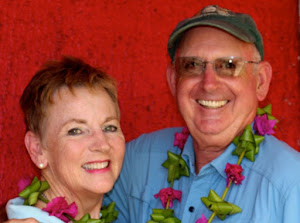Thursday, February 4, 2016, "Bad Lands" near the Rio Leona, WTRD 26
We learned today as we examined fossils, rocks,
and petrified wood that you can quickly differentiate between dinosaur bones and rocks, because the dinosaur bones are hydrophilic (attracted to water). If it is a dinosaur bone, it will stick to the inside of your inner lip. I think I found one!
Too bad, all finds had to be left behind, no souvenirs. It's been a very interesting day.. We loved it.
Yesterday, was partly cloudy and windy as rain clouds passed over the desert. Today, we awoke to beautiful clear skies. Unlike the summer desert in Las Vegas, today was cool and windy, in the high 60's. It is a perfect day for hiking in the Bad Lands. And that is where we are headed.
Russ and I were picked up at our BnB around 9:30 and driven about 130 kilometers out of El Calafate, to an interesting geological valley where we hiked for three hours in the Bosque Petrificado La Leona. Before we turned off the main road, we stopped at the La Leona Hotel where Butch Cassidy, Sundance Kid, and Edith Place hid out for a month before leaving for Bolivia where they were ultimately killed in a shootout with the police.
Our guide explained that this was not a Shakespeare moment of
To Pee or not to Pee, it was a must pee because the area we are in which we will be hiking has no facilities. Cute! So our little group of about 15 people all did our thing, and had some snacks as well before heading into the Bad Lands in our four wheel drive.
We climbed up a mountain and came to a stop high atop a plateau. The sight that met us as we peered over the plateau was vastly different than the area we were standing on and had driven through to get here. In many ways it has the erosive qualities of South Dakota's Bad Lands or Bryce Canyon, but without the immensity and color.
Approximately 75 MILLION years ago, The west coast of South America, Chile and Argentina were flat river valleys, receiving 300 centimeters of rain a year and was lush, wet, and jungly and the home to dinosaurs. When the Pacific tectonic plate collided with the South American Plate, the the Pacific plate pushed under, the South American plate pushed over on top and curled forward creating the Andes mountain range. With the collision and pushing, magma oozed up from the depths pushed down by the Pacific plate and covered the region in iron rich basalt approximately 15-20 feet thick.
This dense metallic like covering provided a protective covering over the rich valley plains before the ice age began. The Andes as they rose, began to capture the rain fall as snow at the higher elevations. This snow built up to make the beautiful glaciers that can be seen today. The eastern slope of the Andes is dryer, and the flat areas east became dry windswept deserts, subject to freezing cold temperatures.
As the snow and glaciers were laid down and eventually started to crush their way downward, those areas not protected by the basalt eroded away more quickly, creating deep canyons and new valleys. The original river valley that was protected by the basalt did not erode as quickly and eventually became mountains and flat high plateaus as the unprotected areas washed away around them.
The area was eroded first by glaciers, eventually crushing through the basalt towards the end of the ice age. Subsequent erosion, began too expose the underlying treasures of trees and dinosaur bones captured under the protective basalt layer. Today, what is visible is this fragile mud and sand stone sculpted mountains, valleys, and caves with fossil finds making their way to the surface. We were reminded of Cappadocia and the Fairy Chimneys in Turkey. However these mountains are more fragile and mud like rather than sandstone. The caves were never inhabited by indigenous people. Pumas are usually the only inhabitants when birthing cubs. This puma had a lama for supper near the caves.
On our hike today, we saw broken, rounded, jagged basalt moraine,
unusual eroded formations,
 |
| Looking down on Mountains, not Mole Hills |
biodiverse plant life that has grown in this inhospitable environment,
 |
| Looks like moss covered rocks, but it is all plant that is hard like brain coral |
petrified dinosaur bones and trees.
 |
| Cow femur on left, petrified dinosaur femur on right |
 |
| Petrified Wood |
 |
and petrified wood that you can quickly differentiate between dinosaur bones and rocks, because the dinosaur bones are hydrophilic (attracted to water). If it is a dinosaur bone, it will stick to the inside of your inner lip. I think I found one!
 |
| Another first...kissing a dinosaur fossil. |
Too bad, all finds had to be left behind, no souvenirs. It's been a very interesting day.. We loved it.























































